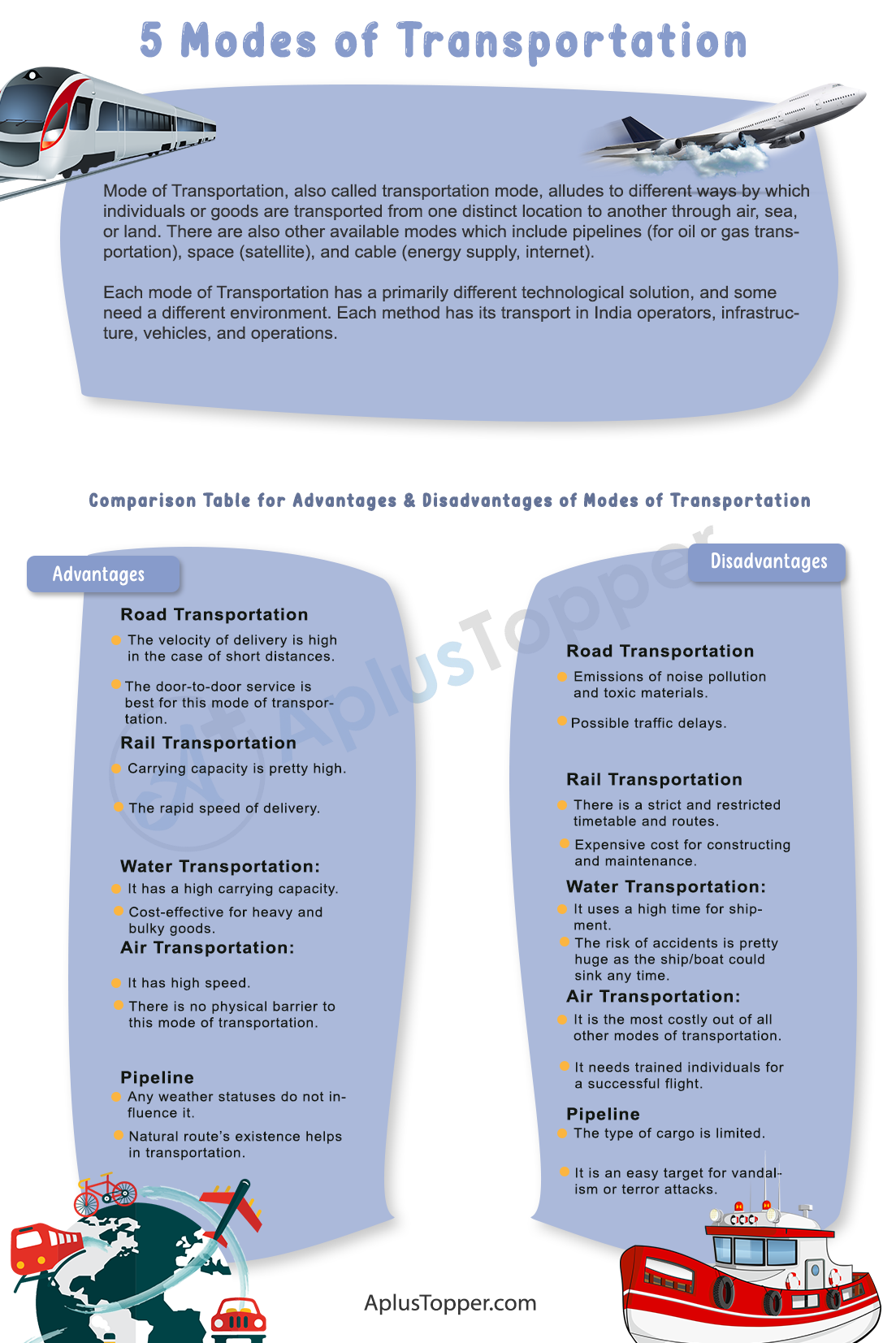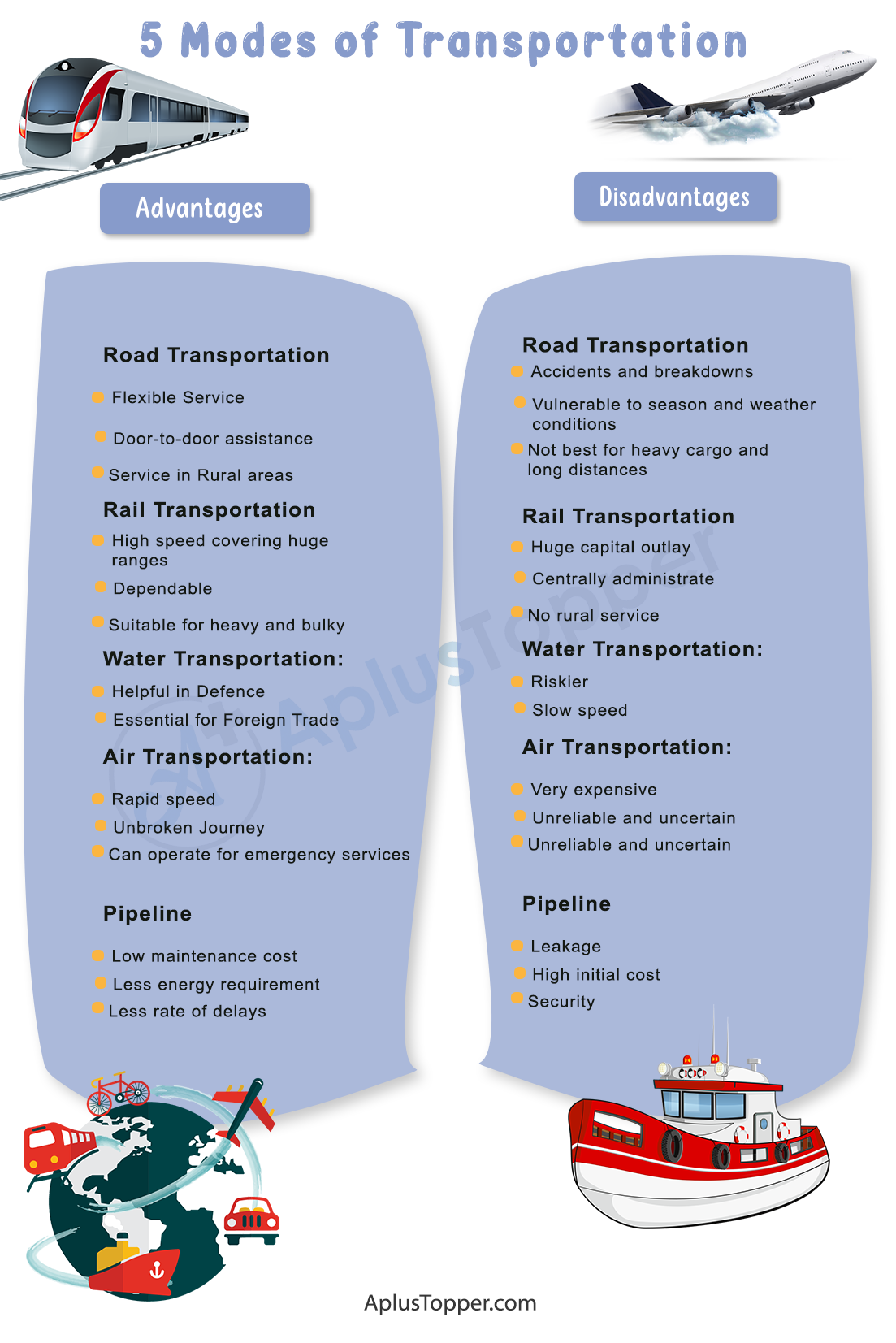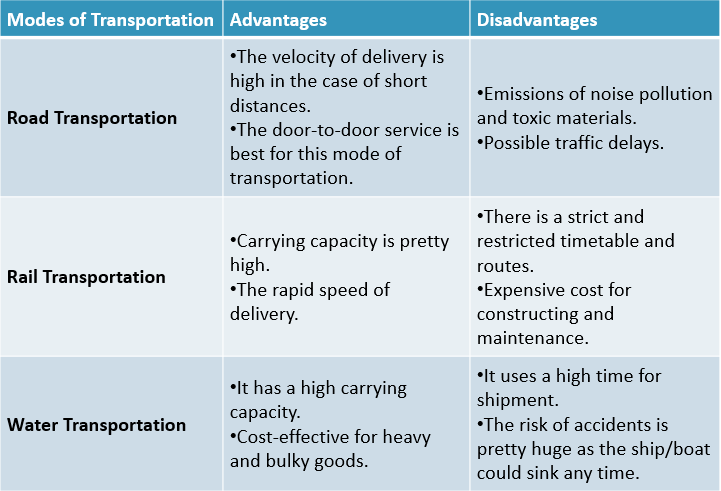Modes of Transportation and Their Advantages and Disadvantages: The term ‘modes of Transportation is utilized to differentiate between various ways of Transportation or transporting goods or people. The multiple modes of transport include water, air, rail, road, and pipeline.
The field can be parted into vehicles, operations, and infrastructure. Modes of Transportation are essential as it facilitates commerce between people, which is crucial for the progress of the human civilization.
Students can also find more Advantages and Disadvantages articles on events, persons, sports, technology, and many more.
Mode of Transportation, also called transportation mode, alludes to different ways by which individuals or goods are transported from one distinct location to another through air, sea, or land. There are also other available modes which include pipelines (for oil or gas transportation), space (satellite), and cable (energy supply, internet).
Each mode of Transportation has a primarily different technological solution, and some need a different environment. Each method has its transport in India operators, infrastructure, vehicles, and operations.
In this post, we discussed at length some of the upsides and downsides of Modes of Transportation.
- Advantages of Modes of Transportation
- Disadvantages of Modes of Transportation
- Comparison Table for Advantages & Disadvantages of Modes of Transportation
- FAQs on Pros & Cons of Modes of Transportation

Advantages of Modes of Transportation
Each mode of Transportation has its advantages, so we have added a few benefits of the four primary methods of Transportation.
Road Transportation:
- Flexible Service: For road transportation, timings and routes can be tuned and changed to suit individual requirements easily; this gives road Transportation a great advantage over all different vehicles.
- Door-to-door assistance: The best benefit of road transportation that makes it the salvation of the transport industry is its character to offer door-to-door services from destination to destination or warehouse to warehouse.
- Service in Rural areas: It is most adaptable and flexible with a reach into the most remote areas that are not accessible by rail, air, or water.
Rail Transportation:
- High speed covering huge ranges: Its speed over long ranges is higher than any distinct modes of transport (aside from airways). Therefore it is the best choice for long-distance traffics.
- Dependable: It is the most reliable mode of transport as it is least affected by weather conditions compared to other methods.
- Suitable for heavy and bulky goods: It is economical, and faster, and best suited for bulky and heavy goods transportation over huge distances.
Water Transportation:
- Helpful in Defence: For the vigorous defense of the country, the development of shipping is vital as it is known as the second line of defense.
- Essential for Foreign Trade: Water transportation plays a critical role in foreign trade as many countries depend mainly on water transportation for foreign trading, such as India.
Air Transportation:
- Rapid speed: Among all the modes of transportation, air transportation is the fastest.
- Unbroken Journey: Air transportation offers an unbroken journey over sea and land, due to which it can take you from one distinct destination to another quickest.
- Can operate for emergency services: It can operate even when every other means of transport can’t due to floods or other natural calamities. So at that time, it is the only mode of Transportation that can be employed to do the relief work and offer the essential commodities of life.
Pipeline:
- Low maintenance cost: Both the maintenance and operation cost is meager.
- Less energy requirement: The consumption of energy is deficient.
- Less rate of delays: The losses of carrying mineral oil and natural gas and delays are minimized with a pipeline system.
Disadvantages of Modes of Transportation
Each mode of Transportation has its disadvantages, so we have added few drawbacks to the five primary methods of Transportation.
Road Transportation:
- Accidents and breakdowns: There is a high risk of breakdowns and accidents in the instance of road transport, due to which it is not a safe or predictable option.
- Vulnerable to season and weather conditions: It is very susceptible to weather conditions and seasonal changes or, in the case of natural calamities such as floods or heavy rains.
- Not best for heavy cargo and long distances: It is not very appropriate for transporting heavy cargo over long distances, which is a considerable drawback.
Rail Transportation:
- Huge capital outlay: Rail transportation needs a considerable investment of capital. The funds for building, sustaining, and hanging expenses are enormous compared to other modes of Transportation.
- Centrally administrated: Being the public utility service, rail transportation has a monopoly, and there is centralized administration, so the authorities fail to meet the personal needs of the people as compared to roadways.
- No rural service: It cannot be operated economically in rural areas due to substantial capital needs and traffic, which causes much inconvenienced to the people living in rural areas.
Water Transportation:
- Riskier: It is more dangerous than other modes of transport as there is always the danger of sinking boats or ships.
- Slow speed: It is a quiet mode of transport. Failure of monsoon might result in the fall of rivers’ water level, making navigating the ship or boat difficult.
Air transport:
- Very expensive: It is the most costly mode of Transportation. The fare of transport is very high, which is difficult to afford for the ordinary person.
- Unreliable and uncertain: Air transport is not very reliable and is unsure as it is controlled mainly by weather conditions. Fog, snow, or other unfavorable weather conditions might cause suspension of air service or cancellation of scheduled flights.
- Specialized skills needed: Air transportation requires a specialized skill and a high degree of training for its operation.
Pipeline:
- Leakage: If there is a leakage, the repairing has to be done as soon as possible, so you can’t desert leakage.
- High initial cost: The cost of construction and laying of pipelines is high.
- Security: The security of pipeline transportation is complex.

Comparison Table for Advantages & Disadvantages of Modes of Transportation
| Modes of Transportation | Advantages | Disadvantages |
| Road Transportation |
|
|
| Rail Transportation |
|
|
| Water Transportation |
|
|
| Air Transportation |
|
|
| Pipeline |
|
|

FAQ’s on Pros & Cons of Modes of Transportation
Question 1.
What is the importance of modes of Transportation?
Answer:
The influence of modes of Transportation is that it facilitates trade, communication, and business that builds civilization. It also manages traffic flows and enables steady and undisturbed movement from one location to another.
Question 2.
Which mode of transport is the cheapest mode of Transportation for long-distance?
Answer:
Among all the modes of transportation, rail transportation are the cheapest as they cover a vast distance in less time, and the expense is also less.
Question 3.
What is the main difference between modes of Transportation and means of Transportation?
Answer:
The means of transport is the kind of vehicle one uses, such as car, bus, truck, whereas the mode of Transportation refers to the medium in which the movement takes place, such as waterway, railway, roadway, etc.
